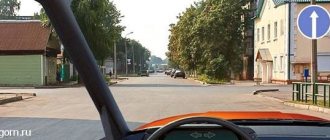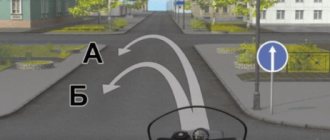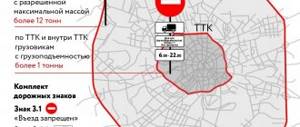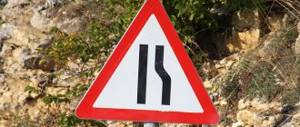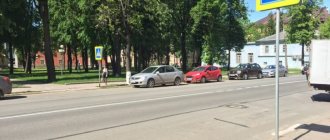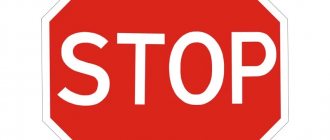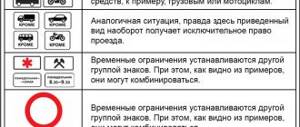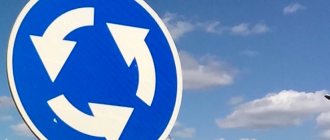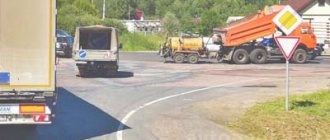Which driver making a turn is breaking the Rules?
| 1. | Only the driver of a passenger car. |
| 2. | Only a motorcyclist. |
| 3. | Both are violating. |
| 4. | Both do not violate. |
Drivers are required to comply with the requirements of traffic lights, road signs and markings. In this situation, road sign 4.1.1 “Move straight ahead” instructs you to move only straight. Traffic light signals only override priority signs.
Features of the sign
Despite the fact that the sign number 4.1.1 “Driving straight” instructs and does not prohibit, it is better to comply with it in order to avoid a fine or provoking a traffic accident.
The following maneuvers are prohibited:
- turn to the left side (or right side - if the sign is at an intersection);
- reversal
The driver of a passenger car is permitted to:
- move along a straight path;
- turn around at the next road intersection if there are no corresponding signs limiting or prohibiting the maneuver;
- when you find a sign after the intersection, drive into the adjacent territory on the right - for example, into courtyards, into a gas station;
- backing up to, for example, pick up a pedestrian.
When turning into a yard or to a gas station, you must remember the general traffic rules and, by turning on your turn signals, warn other drivers about your maneuver.
The territory covered by the sign depends on the location:
- Before the intersection, as well as on the dividing strip. The instructions of the sign must be followed only at the first road intersection or intersection.
- After the intersection. The coverage area extends only to the next intersection, then the sign loses its effect. You can turn anywhere, if it is not prohibited by the rules, or continue moving forward.
The violator may be punished with a fine of 500 - 1500 rubles, or may be limited to a verbal warning. Depends on the severity of the situation. When driving into oncoming traffic, the amount of fines may increase. Proving something wrong can help you avoid a fine. For example, the sign is unreadable, covered in dirt, or hidden in bushes. It will be easier for the driver to prove his case in a dispute with law enforcement officers if he has a DVR.
They can drive where cars are not allowed. But car drivers will be able to continue moving along the desired trajectory where an image of a certain type of transport is installed under the prescriptive designation. Then the restrictions will apply only to the type drawn, most often these are trucks.
Designation 4.1.1 is installed on narrow roads or on highways with a large flow of cars. Compliance with the regulations will help to avoid accidents and create difficulties in the flow of traffic.
What should you do if you need to turn around?
| 1. | Drive straight and turn around at the next intersection. |
| 2. | Drive straight and turn around at the intersection. |
| 3. | Turn around at this intersection if there are no other vehicles at it. |
At this intersection, the road being crossed has one carriageway, and therefore the “Go straight” sign prohibits you from making a U-turn at the intersection. This sign does not impose any restrictions on the section of road following the intersection, where you can turn around. The correct answer is: Drive straight and turn around at the intersection.
Which of the following directions can you continue driving at the next intersection?
| 1. | A or B. |
| 2. | Only B. |
| 3. | In all. |
The “Go straight ahead” sign, installed at the beginning of the road section (behind the intersection), prohibits left turns and U-turns in this section. The effect of the sign in such cases extends to the nearest intersection in the direction of travel, maneuvers at which are not limited in any way by this sign. Therefore, you can move in any of the above directions.
4.1.1 "Move straight"
February 19, 2013 Administrator Home page » Road signs Views:
A mandatory road sign “Go straight ahead” indicates (prescribes) a specific direction of movement, and the driver’s responsibility is to follow this instruction.
In this sense, prescriptive signs are very similar to prohibitive ones. Prohibiting ones introduce a negative regulatory regime (denial - “impossible”), and prescriptive ones introduce a positive regulatory regime (“must”, “must”).
Sign 4.1.1 “Go straight” is one of the most insidious road signs. Driving school students and novice drivers who do not understand the qualifications of the sign risk making mistakes when driving through the road sections designated by it.
The difficulty in understanding the principles of operation of the “Go Straight” sign is due to the fact that it has two – fundamentally different – installation methods. Depending on them, the coverage areas of the sign and its requirements in relation to vehicle drivers differ.
Let's consider the first - the simplest - method of installing a “Go straight” sign. A sign installed before the intersection of roadways extends its effect only to the specified intersection.
In this case, the sign “Move straight” prescribes the only possible option for moving at this intersection of roadways - only straight. However, after passing this intersection it stops “working”.
A very important issue is a clear understanding of the sign's coverage area. It operates at the intersection of roadways. It is at the intersection, not at the crossroads. The fact is that an intersection can be formed by several intersections of roadways.
In this case, the “Go straight” sign will only apply to the nearest intersection of roadways.
The sign does not apply to other intersections of the intersection.
In addition, the exit from the adjacent territory, being an intersection, is not considered an intersection. Therefore, the sign's coverage area will only apply to this intersection.
Consequently, installing a “Go Straight” sign before an intersection leads to a “simple” action, requiring only straight-line traffic at this intersection.
But the second method of installing a sign is more complex and should be rated “insidious.” Agree that the “Go straight” sign can be placed simply in the middle of the road or, as the Rules say, at the beginning of a section of the road.
In this case, the sign's coverage area will extend to the nearest intersection along the route. It is “before the intersection”, that is, at the intersection the sign will no longer “work”.
And now - the most important thing. The “Go straight” sign until the next intersection will strictly prohibit turning left or making a U-turn. It will require straight-line movement. But at the same time, as a bonus, the driver is allowed to turn (“sneak”) to the right into courtyards or other adjacent areas.
In other words, the sign in its “insidious” expression is placed to prohibit turning left and turning around at the nearest intersection along the route.
For what? For what? Why?
This is exactly how an inquisitive mind will react, for which dry lines of legal norms are not enough. And the answer is very simple. This method of installing a sign is used on narrow sections of roads, in areas with heavy oncoming traffic or in those areas where there is a real danger when making maneuvers associated with a left turn and, especially, a U-turn.
For example, when performing similar maneuvers on a narrow road, the driver has to give way to vehicles coming from the opposite direction. This, in turn, can lead to traffic jams or congestion.
And there’s no need to talk about heavy traffic and potentially dangerous areas; here left turns and U-turns are excluded for road safety reasons.
The permitted right turn into the adjacent territory (yards, gas stations, parking lots, etc.) should not raise doubts. When turning right, the trajectory of the vehicle does not intersect with the trajectories of oncoming vehicles. Even with a strong desire, a traffic jam does not form behind this vehicle.
Let us summarize the consideration of the second – “insidious” – method of installing a mandatory “Go straight” sign.
- The sign is placed not at the intersection, but in the middle of the road (at the beginning of the section of the road, which it forms by itself).
- The sign will remain in effect until the next intersection.
- The sign will prohibit U-turns and left turns into yards and other areas adjacent to the left, but will allow similar right turns.
Thus, each driver, before starting to act on the “Go straight” sign, must clearly distinguish between two – “simple” and “insidious” – cases of installing this sign and remember that they are different:
firstly, the location of the sign - before the intersection (“simple” method) or at the beginning of the section (“insidious” method);
secondly, the coverage area of the sign - only at the intersection (“simple”) or to the nearest intersection in the direction of travel (“treacherous”);
thirdly, the permitted directions of movement are only straight (“simple”) or straight and into the territory adjacent to the right (“insidious”).
And finally, a couple more comments.
Firstly, the driver must be prepared for the fact that the “Go straight” sign may also appear on the left side of the road or the dividing strip. This is done solely for timely information about the introduced regulatory regime. And if there are a large number of lanes on the roadway, the Rules allow you to hang a sign above the leftmost lane.
And, secondly, the “Go straight” sign can be ignored by drivers of route vehicles. He makes an exception for them.
If this information was useful to you, please write about it in the comments. If you have any questions, write, we will definitely try to help you.
Traffic regulations online from the autoass team!
The content of the article:
- straight ahead sign
- sign 4 1 1
- straight ahead sign
- straight ahead sign
Tags: moving straight
What trajectory are you allowed to make a turn on?
| 1. | Only according to A. |
| 2. | Only according to B. |
| 3. | None of the proposed ones. |
The “Go straight” sign is valid only at the nearest intersection of the roadways in front of which it is installed (up to the dividing strip). Turn around at the second intersection, i.e. along trajectory A, allowed.
Mandatory road sign "Go straight ahead"
A road sign requiring straight movement allows the driver to move only in the straight direction. This sign prohibits movement in all other directions.
Features of the straight ahead sign:
- if it is installed at an intersection, then its effect extends only to the intersection of roadways in front of which it is installed;
The straight ahead road sign allows the driver to move only in the straight direction.
- If a sign is installed outside an intersection, its effect extends to the nearest intersection. At the same time, it is not prohibited to turn right to enter the adjacent territory;
- route vehicles have the right not to comply with the requirements of this sign.
A straight ahead only sign can be installed, for example, in a gap in the dividing strip, to prevent vehicles from turning left and turning around.
Violating the requirements of this sign may result in your vehicle ending up on a one-way road and driving there in the opposite direction. Naturally, this is quite dangerous, and such a maneuver is punishable by deprivation of rights.
In which directions are you allowed to continue driving at the intersection?
| 1. | A or B. |
| 2. | B or V. |
| 3. | Only B. |
At this intersection, the road being crossed has two carriageways; the “Go straight” sign is valid only for the first intersection of carriageways in front of which it is installed. Therefore, you are only prohibited from turning right onto the first carriageway (direction B). The correct answer is A or B.
Installation rules according to traffic rules
The area of its coverage will depend on the location of the “go straight ahead” sign. There are two options:
- Before crossing roads. Applies only to the nearest junction of roadways. That is, if the driver sees 4.1.1 in front of such a place, he can only go straight, but immediately after he can go anywhere, unless there are other prohibitions. Here it is important to distinguish an intersection from a crossroads, since it can consist of several intersections, and the action is canceled immediately after the first one.
- On any other section of the road. In this case, it is valid until the next intersection and is canceled already there, at the very beginning.
Most often, if 4.1.1 is installed not before the intersection, but directly on the roadway, the road is either too narrow or dangerous. The restriction has been introduced to provide additional security. Therefore, any maneuvers are prohibited, primarily to the left. Turning right into any yard does not cause any additional risk.
Installation rules 4.1.1 - 4.1.6 are determined by GOST R 52289-2004. This act contains some additional features:
- in a situation where both prescriptive signs 4.1.1 - 4.1.6 and prohibitive signs 3.18.1 - 3.18.2 can be used, GOST obliges the use of prescriptive ones;
- additionally used to prohibit a turn if there is a gap in the markings;
- If necessary, symbols can be used to repeat the road marking requirements numbered 1.1 and 1.3 (solid and double solid lines).
If a road has at least two lanes of traffic, a “go straight ahead” sign may be located on the left lane or dividing line.
Which courtyard can you enter in this situation?
| 1. | Just to the left into the courtyard. |
| 2. | Just into the courtyard to the right. |
| 3. | At any. |
| 4. | Turns into courtyards are prohibited. |
The “Go straight ahead” sign, installed at the beginning of the road section (behind the intersection), prohibits left turns into courtyards and U-turns in this section, without limiting entries into courtyards located on the right.
What trajectory are you allowed to make a turn on?
| 1. | Only at the intersection - along trajectory A. |
| 2. | Only before the intersection - along trajectory B. |
| 3. | Along any of the proposed trajectories. |
| 4. | Not along any of the proposed trajectories. |
The “Go straight ahead” sign is installed at the beginning of this section of the road, and its effect ceases at the intersection following it. This means that you can only make a turn along trajectory A. You cannot turn around along trajectory B, since the sign’s instructions are still in effect in this place.
In which directions are you allowed to continue driving in a passenger car?
| 1. | Just straight ahead. |
| 2. | Only left or right. |
| 3. | In any. |
A “Vehicle Type” plate with a picture of a truck applies the “Go Straight” sign only to trucks with a maximum permissible weight of more than 3.5 tons. Thus, you can drive through the intersection in any direction.
At what distance does the movement really go straight
Many drivers, especially in disputes with traffic police officers, try to explain that they were incorrectly oriented and could not determine the coverage area of this sign. In fact, this question should not cause any difficulties, since there are only two options.
When this sign is installed in front of an intersection, it is valid only within the boundaries of this specific road intersection. When installed outside an intersection, on a flat section of the road, it prohibits maneuvers involving a left turn/U-turn to the nearest intersection.
There are no further nuances in terms of the coverage area of this sign. Particular care should be taken when making turns. So, if a traffic sign is installed directly in front of an intersection, a U-turn can be made only after passing it - this maneuver cannot be performed in front of it.
Drivers should pay attention to this point as well. If under the sign itself there is additionally attached a sign depicting a specific type of vehicle, for example, a heavy-duty vehicle, then this sign applies only to it; passenger cars can maneuver without restrictions.
Are you allowed to enter the yard beyond the intersection?
| 1. | Yes. |
| 2. | No. |
| 3. | Yes, only if you live in this house. |
The “Go straight ahead” sign in this case only applies to the intersection in front of which it is installed, and does not restrict maneuvers on the subsequent section of the road, where you can enter the yard located on the left.
What mistake does a driver make when entering a yard?
| 1. | Turns in the area covered by the “Go straight ahead” sign. |
| 2. | Turns without turning on the direction indicators. |
| 3. | Makes both of the above mistakes. |
Answer.
- The “Go straight” sign installed at the beginning of the road section does not prohibit right turns into courtyards and other areas adjacent to the road.
- However, before performing the maneuver, it is necessary to signal a right turn, which the driver did not do.
Road sign "Go straight ahead"
The sign looks like a blue metal circle with a white arrow in the center indicating the direction of movement.
The main point is that the coverage area of the regulation differs depending on the installation location. The driver is only allowed to drive straight; turning under the sign is a violation of the rules. However, if a sign is additionally installed under the sign specifying the type of transport, then the regulation applies only to certain vehicles, for example, trucks.
Situations are possible when 4.1.1 is installed on the dividing strip; this is done to prevent turning left
Features of installing a sign according to traffic regulations:
- in circumstances where the sign is located at an intersection, it is relevant only for the first intersection of roadways in front of which it was installed. After passing this section, it is allowed to move not only straight, but also to make turns and U-turns, if there are no other restrictions;
- if 4.1.1 is installed at the beginning of the road, its coverage area extends to the next intersection. The entire area must be crossed in the direction of the sign. At the same time, turning right into any adjacent territory (for example, at a gas station) is not prohibited. This means not an exit onto the main road, but an exit to a roadside area (entering courtyards).
Exceptions are provided for public transport; if a route runs through this section, they can turn left or make a U-turn within the coverage area of the straight ahead sign.
If a straight ahead sign is installed in front of an intersection, it is prohibited to turn right, turn left or make a U-turn
There may be situations when 4.1.1 is installed on the dividing strip; this is done to prevent turning to the left. This often happens on roads with a large flow of traffic.
What road sign 4.1.1 prohibits
If a sign is installed before an intersection, it is prohibited to: turn right; a left turn or U-turn (for the first crossing), but if the road being crossed has a median, then a left turn or U-turn is allowed. If a sign is installed after an intersection, it is prohibited to: turn left; reversal
What trajectory can you use to make a turn?
| 1. | Only according to A. |
| 2. | Only according to B. |
| 3. | For any reason. |
The road adjacent to the left has two carriageways, and the sign “Move straight ahead” is valid only at the first intersection of the carriageways in front of which it is installed, prohibiting left turns and U-turns here, and at the second intersection there are no restrictions on maneuvers, and here you can turn around (trajectory B). The correct answer is - Only according to B.
